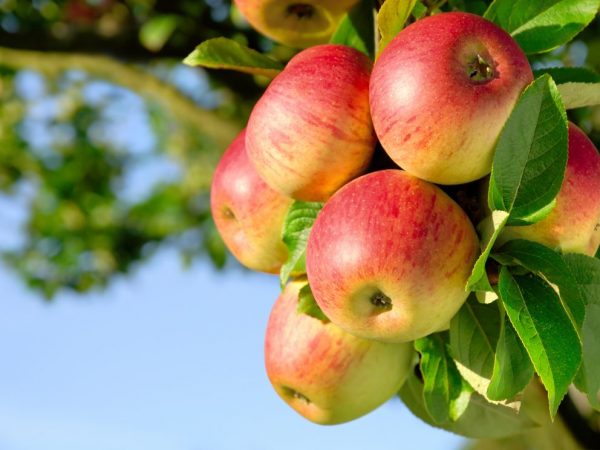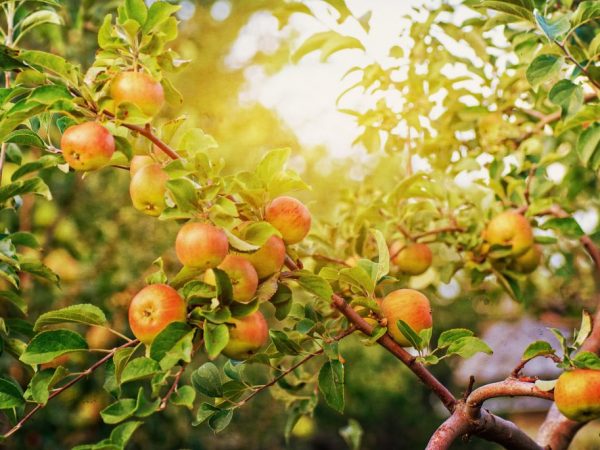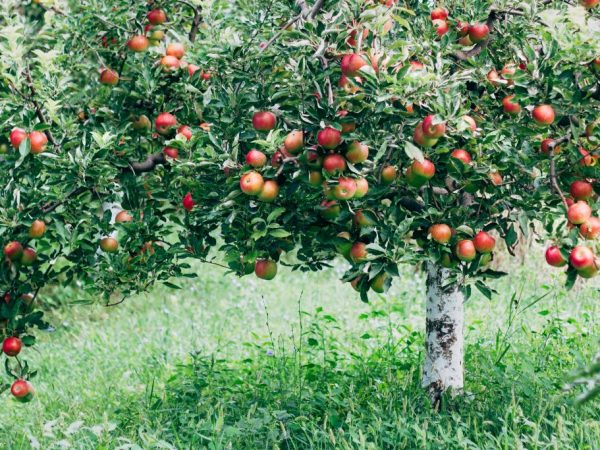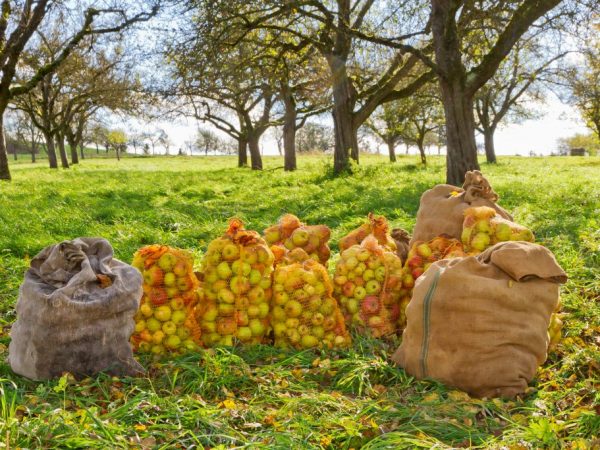Growing an apple tree Cinnamon striped
The Cinnamon striped apple tree was bred 200 years ago by the breeder Levshin. Throughout its history, it gave rich harvests, and also became the "progenitor" of more than 15 varieties of wood. For the entire period, the view did not improve and was rightfully considered one of the elite. There is also a variety called Brown.
- Description
- Characteristics of the tree
- Description of fruits
- Advantages and disadvantages
- Taste
- Yield
- Winter hardiness
- Landing
- Timing
- Technology
- Care
- Watering
- Top dressing
- Pruning
- Protection against diseases and pests
- Ripening and fruiting
- Harvesting and storage
- Varieties of varieties
- Growing regions
- Gardeners reviews

Growing an apple tree Cinnamon striped
Description
Cinnamon striped is an autumn type of apple that is successfully pollinated if it grows near apiaries. The bees love the fruits of this tree, and thanks to their activities, the yield level increases. Also, the variety is pollinated by trees of other varieties and does not require special conditions for growth.
As an autumn species, the apple tree bears fruit in September, and if the summer was hot and sunny, ripe fruits can be harvested already in August.
Variety characteristic:
- autumn;
- short shelf life of fruits (2-3 months);
- self-pollinating;
- average size of apples.
Characteristics of the tree
Apple trees of this variety are pyramidal trees with a massive crown. The tree reaches a height of 5 m, and the width can be 4 m. Every year the crown becomes more powerful and thicker, maintaining rapid growth.
The branches of the tree are short, lowered, the foliage is concentrated at the top of the crown. It has a characteristic dense green color, the leaf shape is sharp.
The flowering period - mid-May - is distinguished by a special aroma that attracts bees and other pollinators to the pink flowers.
Description of fruits
Fruits are medium in size, flattened in shape, color corresponds to the name - with clear traces of vertical brown stripes. On average, one apple weighs 80 g, but there are also larger fruits.
At harvest, the color may differ slightly from that which appears during the ripening stage. The fruits can be greenish in color, they are smooth, covered with natural wax, shiny and glossy.
Advantages and disadvantages
This variety can rightfully be called the most frost-resistant. Even in severe winters, the trees withstood the cold, waited for spring, and in the fall brought the long-awaited harvest.
The taste of the fruit brings this variety to the leading positions in the apple rating. The characteristic note of cinnamon, thanks to which the apple tree got its name, will appeal to everyone. Fruit is in great demand in the market and in the home kitchen. They make excellent jams, and baked goods with this variety will have an exquisite taste.
The disadvantages include low yield. Cinnamon striped can produce up to 140 kg of fruit per year. You have to wait for such a harvest up to 10 years after planting a tree.
Also, the disadvantages include the excessive "tenderness" of the fruits themselves: at the slightest physical impact, the quality of the apple is lost, so you should not wait until the fruits begin to fall. They are harvested earlier, otherwise the gardener risks losing the presentation of the fruit.
Taste

The fruits taste good.
The pronounced and characteristic taste of this apple variety will appeal to every consumer. Subtle notes of cinnamon, along with a light taste of beeswax, create a unique tandem.
The taste of the fruit has the following characteristics:
- sweet (sugar content up to 10%);
- light acidity (no more than 0.5%);
- cinnamon flavor.
Yield
The apple tree yields an average - about 150 kg per year. If an apiary is located nearby, insects with their pollination can double the number of fruits. Harvested in late summer - early autumn.
Removing the fruit should be done as carefully as possible so as not to damage the apples. To store fruits for up to six months, you need to prepare a dry place for this.
Winter hardiness
Cinnamon striped apple variety tolerates frosts perfectly. The tree is not afraid of temperatures even below -35 ° C. If the grower uses mulch to retain moisture, the tree can withstand any cold weather.
Landing
Brown does not possess distinctive features of planting. She loves moist fertile soil, rich in minerals. If the ground is sandy, the tree can develop quite well, but subject to high-quality and regular watering and feeding.
In the garden, the south side should be set aside for this tree, on which there will be a lot of light. The description suggests that trees should not be planted close to each other, so as not to impede air exchange during pollination. The optimal distance between them is 3 m.
When planting, be sure to take into account the location of groundwater: if they are too close to the root system, this can adversely affect the garden.
It is better if the waters are located at a depth of 2 m or more. If they go higher, you can prevent the roots from growing deeper by creating an artificial barrier. It can be flooring made of bricks, clay or slate. You can also plant a tree on a hill, raise the ground.
Timing
It is better to plant seedlings in the spring. The land must thaw and dry out, trees are sown until May. If cultivation takes place in the fall, planting should take place only after all the leaves have fallen, but not later than the onset of frost.
Technology
For the tree to take root, the soil must be enriched with minerals and well drained. Brown does not tolerate high humidity.
It is recommended to plant young trees in mid-spring. A hole is dug up to 1 meter deep. It is better to put soil mixed with manure on its bottom, and sprinkle with dry earth on top. You need to find out the proximity of the location of groundwater, if necessary, create a protective barrier of bricks or stones.
Slate is also laid at the bottom of the pit. Make sure that the roots are well fluffed and spread. Then the seedling is placed in the ground and tamped tightly.
Be sure to leave the root collar at a level of 10 cm above the soil. The tree is tied up and watered after planting.
Care

The tree needs regular watering
Old and dry branches are pruned in the spring. Coarse bark should be peeled off to avoid the appearance of fungus. Twice a year, they are treated with fungicides and insecticides, as well as fertilized. This kind of care is needed by the culture every year.
Watering
The tree needs frequent watering: up to 5 times a month (once a day, a bucket of water for one seedling). Particular attention should be paid to watering at the end of summer, this is an important period of fruiting. At this stage, new buds are laid, which will give the next harvest.
If the tree suffers from thirst, this can adversely affect the amount of fruit harvested.
The end of watering must be adjusted according to weather conditions. If the summer is hot and without precipitation, the tree does not stop watering so that it continues to saturate and prepare to retain moisture for the winter. If the summer has been mild, watering ends at the end of the summer.
Top dressing
The best feeding for this variety is all organic fertilizers and humus. Urea and mulch are great solutions.In the fall, use complex fertilizing, but without nitrogen content.
If the land is fertile and rich in minerals, there is no need to add fertilizer. If the soil is mixed with sand, fertilizing should be a regular event.
Pruning
The tree is pruned in the spring. This is done not only to give the apple tree a beautiful look, but also to avoid infection with various diseases.
Pruning occurs once a year, until the buds have blossomed. All old and dry branches are removed, about ¼ of the entire tree.
Protection against diseases and pests
The cinnamon striped apple tree has a weak resistance to fungi and pests.
The most dangerous for her:
- apple sucker;
- red tick;
- leaf roll;
- moth;
- scab;
- root cancer;
- cytosporosis.
You need to fight copperhead with benzophosphates, enough for spraying 10 liters of water, 60 g of the chemical are dissolved in them. Before that, the hard bark is peeled off from the tree.
"Nitrofen" is good against ticks: for 10 liters of water you need 250 g of the substance. Spraying is necessary before the buds appear.
The leafworm will not appear after wintering if the tree is treated with chlorophos before the onset of heat (10 ° C). To do this, take 20 g of the chemical per 10 liters of water.
The moth is easy to eliminate with trapping belts. The tree needs to be tied with adhesive material, then the insect will not be able to get to the fruit and will die. It is necessary to remove fallen apples so that the moth does not feed and does not multiply on the ground.
Spraying 10% potassium chloride works well against powdery mildew. All leaves and branches that have had time to get sick must be cut off and burned.
There is no cure for root cancer if it has managed to infect the root collar. In this case, the tree will have to be burned. Root cancer is a danger to seedlings. At the initial stage and the emergence of small growths, they can be cut off and treated with copper sulfate.
Cytosporosis is fought with copper sulfate.
Ripening and fruiting

You can get 150 kg of fruits from one tree
Young trees ripen only 5 years after planting. In the early years, the yield is not distinguished by a large number of fruits. Upon reaching 10 years of age, the tree begins to bear fruit confidently and powerfully. Older apple trees yield a harvest every few years.
The fruits can be harvested at the end of summer. The average yield is 150 kg per year from one adult Brownie.
Harvesting and storage
You need to harvest with utmost care, without waiting for the apples to begin to fall. The fruits of this variety have a very fragile structure, the slightest bruises can affect the quality and storage of the fruit.
It is advisable to use the damaged apple in the first few days, then it will be unusable. Because of this feature of the fruit, experienced housewives make preserves and jams from fallen or beaten apples. Apples can be frozen for baking or compote.
It is better to store crops in wooden boxes with access to air. Do not load the box with fruits, be sure to fold them neatly, filling the voids with paper, sawdust or hay. It is better to store apples in the basement or on the balcony.
Varieties of varieties
The apple tree of this variety has the following types:
- Cinnamon new;
- Pineapple;
- Gray.
Cinnamon new has a slightly larger fruit, they are harvested in late September or October. The tree itself is more resistant to parasites, has increased immunity.
The pineapple tree has larger fruits, juicier flesh, and a bright red color. Stored for up to a month.
Gray differs from Cinnamon striped only in the color of the peel: there are no characteristic stripes, a scarlet color.
Growing regions
The most suitable place for growing is the Moscow region. The climate in this region is moderately mild with snowy winters. If there was little rainfall in the cold season, you can play it safe and add mulch to the soil.
In the Urals, Brown also grows well, but there is a risk of recurrent frosts. If the buds freeze, the entire crop will die.
Gardeners reviews
Gardeners love this variety: although it is whimsical and capricious in harvesting, it bears tasty fruits. The characteristic and unique taste of apples will appeal to everyone. They are suitable both for fresh use and for various kinds of blanks.

